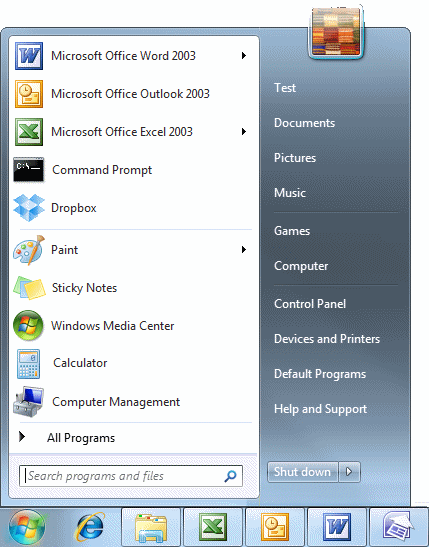
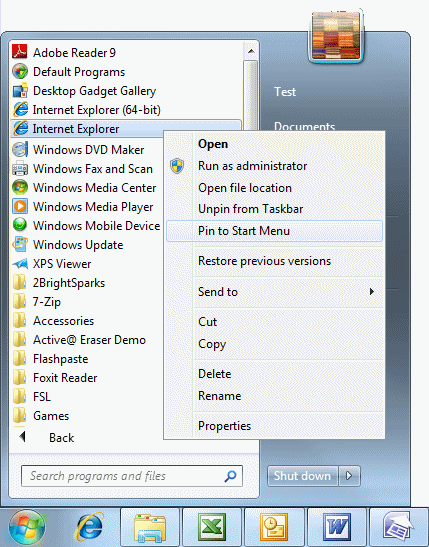
This page describes the settings concerning the Windows 7 user interface to improve the user experience.
The Start menu can be used to quickly start the installed programs. The programs are divided in two sections: the quickly available programs pinned to the start menu (the upper section) and the recently opened programs (below the horizontal line). By default this menu is filled with less important programs, while most of the time the newly installed and important programs are hidden behind the sub menu All Programs. By right clicking a program and selecting Pin to Start menu (like shown below), a program can be added to the short (but quickly available) list of programs in the Start menu.


Default Programs vs. All Programs
Every newly installed program ads a folder and shortcuts to the menu All Programs (unless this option has been disabled at setup), which makes the program easy to find. This list can be a mess, especially when a lot of software has been installed therefore a more logical structure (like pinning a program to the taskbar or adding a toolbar to the taskbar as described below) would improve the overview.
USING THE SEARCH FIELD TO FIND AND START A PROGRAMPrograms which aren't pinned to the Start menu (or placed elsewhere within easy reach) can be started easily by typing the first letters of the program in the search field of the Start menu Search programs and files. The search results are shown in the Start menu. |
|
|
Changing the lay-out of the Start menu
The lay-out of the Start menu can be changed by right clicking an empty area of
the Start menu and selecting Properties. To show or hide the shortcuts on the right side of the
Start menu, select the button Customize on the tab Start
Menu.
If preferred, hide the shortcuts to Devices and Printers,
Help and Support, Games and
Default Programs from the Start menu and add the shortcuts to Favorites menu,
Recent Items, Videos and Recorded TV. By disabling the alphabetic ordering,
the shortcuts to folders and programs can be ordered as desired (option
Sort All Programs menu by name).
After disabling this option, the order can be changed by dragging and dropping
the shortcuts. In case
the Start menu is to small to show all programs, the size of the shortcut icons can be adjusted in size by
disabling the option Use large icons. Disable the option Highlight newly installed
programs if it the yellow highlighted
background of the newly
installed programs in the folder All
Programs of the Start menu is not desired.
Minimize the number of shortcuts to programs in the folder Startup
The programs with
a shortcut in the folder Startup (in the subfolder All Programs of
the Start menu) will start automatically with Windows. Make sure the programs
which are not used (any more) are removed from this folder. By default, some programs
place a shortcut in this folder to a small executable which prepares a quick
start of the program or start other programs. These startups occupy rare system resources,
remove them (by
drag-and-drop) when there is no added value!
CHANGING THE START MENU USING THE WINDOWS EXPLORERThe shortcuts in the folder All Programs are stored on two different locations: one folder with shortcuts to programs for all users (C:\ProgramData\Microsoft\Windows\Start Menu) and one folder with shortcuts to programs for each individual user (C:\Users\loginname\AppData\Roaming\Microsoft\Windows\Start Menu). Use the Windows Explorer to browse these folders and add or remove shortcuts and subfolders. |
Changing the default folder to open the Windows Explorer
The button Computer (part
of the Start menu) opens the Windows Explorer, by default in the 'folder'
Computer. Although this
location can be of use, it is not always the most practical folder to start
with. To change the folder which is opened by default, right click the preferred
folder in the Windows Explorer and select Send to,
Desktop (create shortcut).
Open the Properties of this shortcut (right click the shortcut) and
change the command for the variable Target. The command "D:\"
for example will open the Windows Explorer in the root of the partition with the
letter D: (tip: select Maximized
for the variable
Run to open the Windows
Explorer using the full screen by default). After the name of the shortcut has
been changed, move the shortcut to the Start menu by drag-and-drop.
The behavior of the Taskbar can be changed by right clicking an empty area of the Taskbar follow by Properties. In Windows 7 it is better not to use the option to hide the Taskbar (Auto-hide the taskbar) because Windows 7 shows some of the administrator messages on the Taskbar. If these messages waiting for confirmation are not visible by the user, it is not clear why there is nothing happening. A double height of the Taskbar (by dragging the top of the Taskbar upwards) creates more space for the Quick Launch menu and the active programs. This change creates more space to show both the time and date. To be able to drag the top upwards, the Taskbar must unlocked by right clicking it and choosing for Lock the Taskbar.
In Windows 7 the Taskbar has been improved resulting in a better user experience. As soon as a program is opened the program icon is added as a button to the taskbar (when multiple windows of the same program are opened, the buttons are stacked). The Quick Launch menu of previous versions is no longer used; the shortcuts to frequently used programs are placed directly on the taskbar (and changes in a button when the program is activated). A program can be pinned to the taskbar by right clicking the program icon on the taskbar and selecting Pin this program to taskbar (select Unpin this program from taskbar to unpin the program). The order can be changed by drag-and-drop.
The shortcuts pinned to the taskbar can be activated with both the mouse and the keyboard. By using the Windows-key in combination with a numeric key one of the programs is opened (the number of the program to be used depends on the order on the taskbar from left to right, e.g. the Windows key in combination with 1 opens the first program on the left, by default this is the Internet Explorer). If the program was already opened, the windows will be activated or deactivated depending on the status of that moment (if multiple windows are open, this key combination can be used to browse these windows). By hovering a button of a program with the mouse, a popup window is shown with miniature versions of the opened windows for that program. These mini windows can be used to activate of close the concerning window. By hovering the mouse over one of these mini windows, the original window is temporarily shown at the foreground.
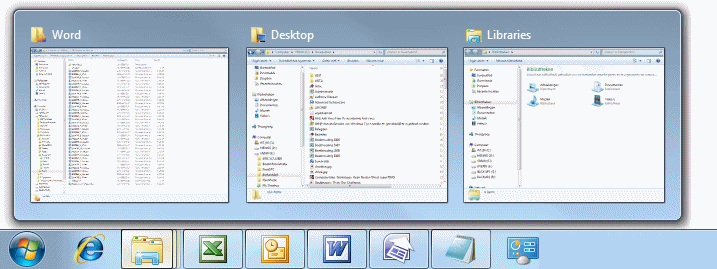
Jump List
By right clicking a program icon on the taskbar, a so called Jump
List is shown with options like recently opened files or visited web pages.
But there are more options like opening a new window (which can be done faster
by holding down the SHIFT-key as soon as a program icon is clicked),
closing all opened windows,
pinning a program to the taskbar and depending on the program some additional
features. The picture below shows the Jump List belonging to the Control Panel.

The Jump List only shows a few recently opened items. By default this number is maximized to the 10 most recent opened items but can be increased: right click the start button, option Properties, button Customize and change the number shown by the option Number of recent items to display in Jump Lists at the bottom. A frequently visited website or opened file can be permanently pinned to the Jump List of a program as well: right click a recently opened item in the Jump List and select Pin to this list (or just by dragging a shortcut of a file to the taskbar).
TIP: If the Control Panel is frequently used it is wise to pin this panel to the taskbar by opening the Control Panel, opening the Jump List of the Control Panel and selecting the option Pin this program to taskbar. This trick can be applied to almost all windows especially when it is hard to create a shortcut!
Changing the behavior of the taskbar
The behavior of the Taskbar can be changed as well. By dragging the top of the
taskbar upwards, the height of the taskbar can be enlarged (to make space
available for more program icons). Right
click the taskbar and deselect Lock the Taskbar first to accomplish this.
Right click an
empty area of the Taskbar followed by Properties for additional option
like Auto-hide the taskbar
(to make space available for the active programs) and Use small icons (to
fit more program icons on the taskbar).
SOLVING PROBLEMS WITH THE JUMP LISTWhen the Jump List of a program doesn't show any of the recent and pinned
files any more, it is not that easy to fix it. The file which contains the Jump
List information has to be deleted, the problem is to find out which file
contains the information of the specific Jump List. These files are stored in
the folder: There is a file for each icon on the taskbar. The filename doesn't give any clue which program a file is for, a text editor like Notepad (Start, All programs, Accessories) is needed to find the right file. Open each of these files and search for information (like file names) related to the missing Jump List (this sounds simple but can be hard because these files are quite large). When the right Jump List file has been found, the problem is solved by deleting it. After rebooting the computer a new, empty Jump List is created (the earlier attached items are deleted as well). TIP: There is a quick fix as well: just delete all files to reset all Jump Lists! |
When a lot of programs are installed, the taskbar, the start menu and especially the sub All Programs can become badly arranged. If this is the case, an additional toolbar can be added to get a better overview. Programs and files can be opened quickly by placing them in a toolbar pinned to the taskbar (this toolbar will be shown at the right of the taskbar and can be opened with the »-sign). Such a toolbar is linked to a folder, therefore a folder must be created first (like D:\Menno\QuickStart) to store the shortcuts to the programs and frequently used files (create sub folders if needed). When this folder is created, the toolbar can be added simply by right clicking the taskbar, select Toolbars, New toolbar and select the newly created folder. The shortcuts placed in the sub All Programs of the Start menu (which aren't important enough to pin to the taskbar) can be copied or dragged to this folder.
TIP: A toolbar for the personal files in the folder My documents can be created similarly.
Changing the view of a toolbar
The view of a toolbar can be changed as desired. Right click the taskbar and
deactivate the option Lock the taskbar to be able to make changes to the
taskbar items.
After the taskbar has been unlocked the titles and descriptions of the icons can
be hidden with the options Show title and Show text (right click
the toolbar first). In the example below a shortcut has been added where a space
(" ") is added as first character of the name, which prevents other shortcuts
will be placed on the taskbar. The size of the icons can be changed with the
option View. Finally, the taskbar can be locked by reactivating the
option Lock the taskbar.
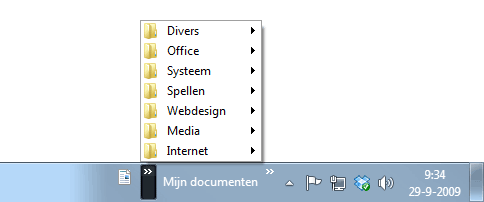
TIP: A toolbar with shortcuts to frequently used programs is similar to the Quick Launch menu from previous versions. In Windows 7 this menu is no longer available because the taskbar has been changed significantly. However, there are still a lot of programs which place a shortcut in the folder C:\Users\loginname\AppData\Roaming\Microsoft\Internet Explorer\Quick Launch. If you miss the Quick Launch menu, one could pin this folder to the Start menu. By drag-and-drop the toolbar can be moved to the right side of the start button.
REMOVING THE LANGUAGE BARThe Language bar (at the left of the system tray, see the example above) can be of use to add a second language or keyboard layout. In most cases however, there is no need for this support in which case it is better hide the Language bar by the Control Panel, Regional and Language, tab Keyboards and Languages, button Change keyboards, tab Language Bar. Another option is to remove the unused installed services on the tab General. Removing the unused input languages prevents the irritating and unintended keyboard layout change as well (which occurs after pressing the key combination left ALT-key and right SHIFT-key). |
Normally the System tray/notification area (at the right side of the Taskbar) is filled with lots of icons of active programs running in the background. The icons are a shortcut to open the program, but most of them are not used at all. Right click the clock and select Properties. The shown window can be used to select which system icons to be shown in the system tray. The icons for the volume, network, battery power level and the action center can be disabled (especially the frequently returning icon for the action center can cause some irritations). To keep the system tray lean and mean, most icons are hidden behind the arrow (at the left of the system tray). When an icon must be visible continuously, just drag it to the taskbar.
TIP: By following the link Customize notification icons (or by the control panel, sub Notification Area Icons), the user can choose to hide or show the icons and/or notifications.
Changing the date and time settings
The notification area show both a clock and the date (by doubling the height of
the taskbar, this area also shows the day of the week). By clicking the
date/time area, the calendar and the analog clock is shown. If the time and/or
date have been set incorrectly, they can be changed following the link Change
date and time settings. The tab
Additional Clocks offers the option to add two additional clocks (for
different time zones) to the pop-up window.
By placing shortcuts to frequently used folders, files and programs can be opened quickly. To keep a good overview, limit the number of shortcuts placed on the desktop (when shortcuts to programs are pinned to the task bar and start menu, there is actually no need to place them on the desktop as well). Be aware that it is not wise to place any personal files on the desktop; it enlarges the risk of losing data! Personal files belong in the folder My documents, if you would like to have quick access to personal files on the desktop, place shortcuts to the files and/or folders by right clicking it and choosing for Send To -> Desktop (create shortcut).
Minimizing programs
When the shortcuts on the desktop are frequently used, the active windows will
have to be minimized frequently as well. Although the programs can be minimized
(or closed) manually, there is a method which works a lot quicker: just click
the button Show desktop
(at the right side of the system tray)
to minimize all windows at once. There is only one negative side effect of this
button: when the mouse is hovered with the mouse, the desktop is shown
temporarily. Disable this feature when it becomes irritating: right click the
button and deactivate the option Peek at desktop.
The Windows-key in combination with repeatedly pressing the arrow down key minimizes all opened programs. The Windows-key in combination with the space bar show (temporarily) the desktop and in combination with the Home-key all but the active window will be minimized (the old situation will be restored after repeating this key combination). By holding down the left button on the active window and to shake the window, all other windows will be minimized.
Sorting icons
The icons of the shortcuts will be ordered nicely by right clicking the desktop
and to select View, Auto arrange items.
The option Align icons to grid can be enabled as well. By default the
icons are quite large but can be resized to a smaller version by holding down
the CTRL-key
in combination with scrolling the mouse wheel.
SAVE AND RESTORE DESKTOP ICON POSITIONSAre you a heavy user of desktop icons, and get irritated when your icons get messed up? Probably the tool IconRestorer (download: http://fsl.sytes.net/iconrestorer.html) is something for you! With IconRestorer you can backup the icon locations and, when needed, restore them easily to the location at the time of the backup.
|
Changing the desktop settings
The item Personalize in the control panel (also available by right
clicking the desktop), option Change desktop icons (at the left in the
task pane) can be used to add or remove shortcuts to the recycle bin, the
network, the explorer and user files. The desktop background image can be
changed by following the link Desktop Background (use the button
Browse to browse the folder with your personal pictures). Select multiple
pictures to create a slide show (change the picture position and the interval as
desired). Unfortunately there is no support for multiple monitors: each monitor
will show the same picture.
AUTOMATICALLY CHANGING THE DESKTOP PICTUREBoring, every day the same desktop picture? Tools like John's Background Switcher (download: www.johnsadventures.com/software/backgroundswitcher/) continuously change the desktop picture after a certain amount of time. This tool supports multiple monitors! Visit the page about automatically changing the desktop picture for more information. |
There are two ways to browse the opened windows: with the Windows-key in combination with the TAB-key for a 3D presentation (known as Flip 3D) with the key combination ALT-TAB for a simple overview. In both cases, jumping to one of the opened windows is done by repeatedly pressing the TAB-key and/or scrolling the mouse wheel.
TIP: In Windows 7, there is no longer a shortcut to Flip 3D available on the taskbar. If you liked this shortcut, you can create one by right clicking the desktop, select New, Shortcut, type C:\Windows\system32\rundll32.exe DwmApi #105 as location and add Flip 3D in the following window. To add the Flip 3D icon by right clicking the shortcut and select Properties, button Change Icon, enter the filename %SystemRoot%\System32\imageres.dll and click OK three times. Finally drag the created shortcut to a location on the taskbar where it is quickly available.
Although the Windows Vista sidebar is no longer used, the user can still add useful gadgets (like different clocks, a calendar, a mini slideshow of personal pictures, stock prices, RSS-feeds, wheather forecasts, ...) to the desktop. Right click the desktop, select Gadgets and drag the desired gadgets to the desktop. The option Get more gadgets online (bottem right) show more interesting gadgets.
ATTENTION: The gadgets can lower the system performances significantly. If this is the case, disable the option to place gadgets on the desktop: right click the desktop, select View and disable the option Show desktop gadgets. This will stop the process sidebar.exe (for compatibility reasons the same name is used as in Windows Vista).
Windows 7 supports different themes to change the desktop background, window color, sounds and screen saver. Right click the desktop and select Personalize to change the current theme (changes are applied immediately). The number of themes available is limited, alternative themes are stored in the (by default hidden) folder C:\Windows\Globalization\MCT (this folder contains regional themes which are activated by double clicking the file in the subfolder Theme), or follow the link Get more themes online for lots more themes.
ATTENTION: When the theme is changed, there is a big chance that some of the desktop icons and the mouse pointer change as well. If this behavior is not desired, right click the desktop, select Personalize. To disallow themes to change the desktop icons, select the task Change desktop icons and deactivate the option Allow themes to change desktop icons and to disallow themes to change the mouse pointer, select the task Change mouse pointers and deactivate the option Allow themes to change mouse pointers.
The monitor is the most important hardware for the interaction between the user and the computer, a good reason to optimize the monitor resolution and other display settings. Right click the desktop and select Screen resolution to change these settings. Change the resolution to the most optimal resolution for the monitor according to the technical specifications else pixels will be interpolated or extrapolated. In most cases the optimal screen resolution is 1024*768 pixels for a 17 inch or smaller screen, for the larger screens try the resolution 1280*1024 pixels (or even 1600*1200 pixels). Use one of the widescreen resolutions in case of a widescreen monitor (see the technical specifications in the manual).
Next click the link Advanced settings and open the tab Monitor to higher the screen refresh rate to the highest possible (at least 75 Hertz) to realize a more stable screen (be careful: if the refresh rate is set to high it will shorten the life time of the monitor) and if possible higher the number of colors to true colors (32-bit). Fortunately Windows 7 automatically sets the resolution, refresh rate and number of colors correctly.
ADVANCED CHANGES TO THE GRAPHICS HARDWAREIf you really want the most out of your monitor en graphics hardware, you have to try the application PowerStrip from EnTech Taiwan (download: www.entechtaiwan.com/util/ps.shtm). With PowerStrip you can make changes to the settings of your graphics hardware and monitor. Your are warned: it's at your own risk, it is possible to make permanent damage! Be careful: read the manual first. By the way: PowerStrip supports almost all graphics cards, check the website if your graphical hardware is supported. If needed, the tool GPU-Z (download: www.techpowerup.com/gpuz/) can be used to find out the technical details of the graphics card. |
Enlarging the text and cursor
If the text on the screen has become too small and hard to read, then
resizing the letters is an option. This can be done by right clicking the
desktop, select Screen Resolution, option Make text and other items
larger or smaller. This window only offers the options to enlarge the text
to 125 or 150%, which is too large to fit the text in some of the windows.
Therefore change the text size by following the task Set custom test size (DPI)
manually. Enlarging to 110 or 115% would be enough for
most users.
A higher resolution also results in a badly visible horizontal cursor in a text
editor. Double or
triple it's height at the Control Panel,
option Ease of Access Center, Make the computer easier to see, Make the focus
rectangle thicker.
Improving the display quality of text
By applying ClearType (smoothing of fonts) the display quality of text
improves, this is done by the ClearType Text Tuner (right click the
desktop, select Personalize, task Display, option Adjust ClearType text).
Activate the option Turn on ClearType and walk through the wizard by
using the button Next. Select the text samples which look best for you to
set the best settings for ClearType.
Aero Snap is a new Windows 7 feature to resize and arrange a window by dragging and dropping it to one of the screen borders (or by using the Windows-key in combination with the arrow key to the left or right). The width and height of the window is automatically changed to exactly fit the left or right side of the screen. This feature is disabled by the control panel, item Ease of Access Center, option Make the mouse easier to use, activate the option Prevent windows from being automatically arranged when moved to the edge of the screen. Right click the taskbar and activate the option Show windows side by side to rearrange the windows for an optimum use of the desktop.
TIP: The Windows-key in combination with the arrow key upwards and downwards maximizes and minimizes programs. In combination with the SHIFT-key the window is stretched vertically.
Nowadays, it is common to work with a big screen (19 inch or more) and/or multiple monitors. Within Windows, it's easier to work with two monitors compared to a single big screen because two screens make it easy to maximize a running program easily to the active screen (half the desktop instead of the whole desktop in case of the situation with one screen). Dragging running programs (if not maximized) to the other monitor is easy as well. The individual position of the monitors can be set by right clicking the desktop, option Personalize, task Display.
TIP: When a projector is connected to the computer, use the key combination Windows-key+P to switch or duplicate monitors quickly!
Extending the taskbar to multiple monitors
Unfortunately, within Windows it is not possible to extend the taskbar or add
another taskbar on the second or third monitor. The tool MultiMon taskbar (download:
www.mediachance.com) makes it possible to extend the
taskbar to the second monitor. The taskbar icon will only be shown on the
taskbar of the screen where the window is active. Every window will have a new
option to move the window quickly to the other monitor, even if it's maximized.
Besides these extra options, the taskbar has the possibility to extend the
clipboard as well. The only negative point is the old fashion look and the poor
Windows 7 integration (because of the new taskbar).
Stretching the desktop background
picture over multiple monitors
The use of multiple desktop background
pictures is not supported as well. Fortunately it is possible to create a
stretched background image (where the different images are placed next to
each other with image editing software) yourself. The size in pixels of the new
image should be equal to the resolution of the used monitors. For example: for a
setup with two monitors with a resolution of 1024*768 pixels needs a desktop
background image with the size 2048*768
pixels. Resize the images to the monitor resolution first (in this example a
resolution of 1024*768 pixels for each picture), place them next to each other
into a single image (in this example an image with a resolution of 2048*768 pixels).
The next step is to change the desktop background image the normal way by right
clicking the desktop and browse to the new image after selecting Personalize, option
Desktop Background. Select the option Tile near Picture position
at the bottom.

TIP: Unfortunately, there are no options to set a different background for each monitor. This can be solved with a tool like John's Background Switcher.
If the graphical card is suitable for the rendering of complicated 3D, Windows 7 will startup automatically with the more advanced Aero Glass-interface which supports transparency. The new interface needs a graphical card with a special graphical processor (GPU) with support for the new Windows Device Driver Model (WDDM). If it is not possible to show the Aero Glass-interface, Windows 7 will automatically return to a less demanding view. The Aero Glass-interface settings can be changed at the Control Panel, item Personalization and follow the link Find and fix problems with transparency and other visual effects to find out why Aero-Glass is disabled.
Less demanding visual settings
If there is a delay in opening, minimizing, maximizing, dragging and closing
windows, disable visual
settings to achieve less graphically demanding settings. Disabling the
transparency (see the picture) has the most effect, especially in case of older
graphical cards or in case the graphical calculations are done by the CPU (in
case there is no graphical card). Disabling the transparency is done by right
clicking the desktop, select Personalize, option Windows Color (at
the bottom) and disable the option Enable Transparency. In the
Personalization windows there is also an option to switch to the Windows 7
Basic theme (or even the classic theme). The example below shows the difference between the Aero Glass-interface (at
the right) and the Basic-interface (at the left with the additional button of MultiMon
which is not visible with the Aero Glass-interface).

Changing the advanced system settings
The advanced system settings
offer more possibilities to change the
visual effects. Go to the Control Panel, item System, task Advanced system settings (at
the left in the task pane), tab
Advanced,
button Settings (as part of Performance). Optimal system settings (while keeping the
most important visual effects)
are achieved after disabling all options (with the option Adjust for best
performance, as shown below) with the exception of Enable desktop
composition, Enable transparent glass (if
desired), Show thumbnails instead of icons
(shows the small images), Smooth edges of screen
fonts
(also known as ClearType), Use drop shadows for icon labels on the desktop
(transparency of the desktop icon labels) and
Use visual styles on windows and buttons.
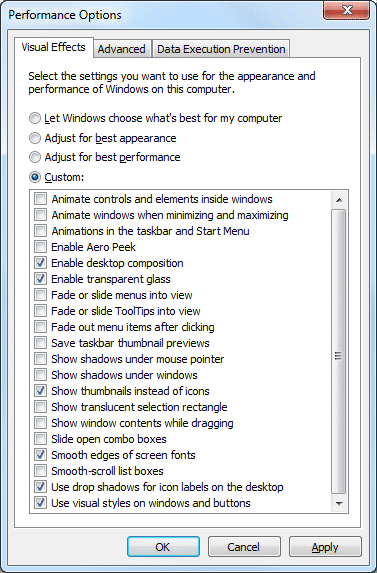
© 2001-2022 - Menno Schoone - SchoonePC - Rotterdam - The Netherlands